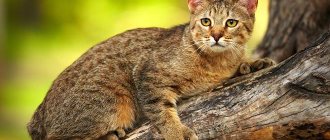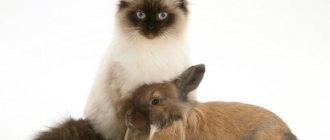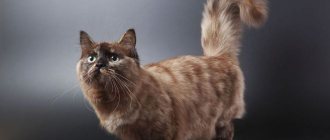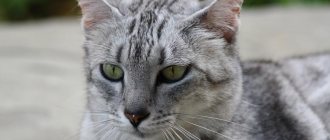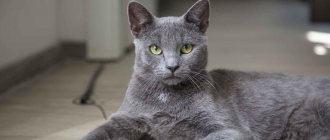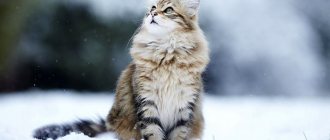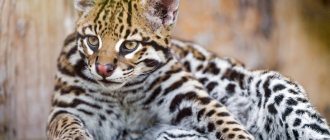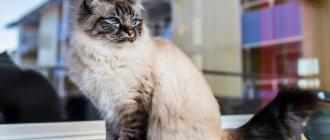| Country of origin | USA |
| Wool | short |
| Weight | 6 kg |
| Lifespan | 16 years |
The Bengal cat has the appearance of a predator and the friendly, balanced character of a pet. Because of these features, the breed, which is called the little leopard, is one of the most popular. The Bengal is a bundle of energy, an incredibly smart, beautiful pet with canine habits. And the colors of Bengals amaze with their diversity.
Origin story
The history of the Bengal cat breed is known reliably. It began in 1963, when biologist Jean Mill crossed a wild Asian leopard cat brought to the United States with her domestic cat. The result of the connection was a kitten with a leopard color. From that moment on, Jean constantly worked to establish a breed whose appearance resembled a wild animal, and whose character was like that of a domestic cat.
The Bengal cat breed is the result of complex selection. It is based on genes and mixed with the blood of the Abyssinian breed, American Shorthair, Egyptian Mau, and Burma.
Nutrition
Bengal cats are carnivores. Often, cat owners (of any breed) forget about this obvious fact. Look at commercial foods and you will see that they contain very little meat, a lot of corn, wheat, soy, potatoes, rice. These types of feeds have only been around for about 60 years. So why are they so in demand? The answer is obvious - they are cheap. Do these foods provide enough nutrients for the cat to survive? Yes. Will my cat thrive on this food? No and no again. The most reliable alternative to such nutrition is natural meat, fish, and vegetables.
Give your Bengal cat plenty of natural foods. Sometimes owners are perplexed: “How can you feed a cat only meat or fish, and even raw?” This is the most natural food for her; we don’t think anyone believes that for the previous 9,000 years the cat ate exclusively dry food and canned food.
Description and standard
In 1986, the breed standard was approved. The next year there was the first exhibition. Official recognition was received in 1991, when the Bengal cat took part in the TICA championship. Now all felinological organizations have recognized the breed.
The table below provides a description of the breed:
| Become | Breed characteristics |
| Body type | Muscular. The female is slimmer than the male and weighs less. The average weight of an adult cat is 7-7.5 kg. The bones are strong. A thin physique is not allowed. |
| Head | Wedge-shaped, slightly elongated. Looks proportional to the body. The shape is very different from the head of a domestic cat. |
| The whisker pads are thickened. | |
| The chin is square and powerful. | |
| The ears are small or medium-sized, wide at the base and rounded at the tips. Lynx ear tufts are not desirable. | |
| The eyes are almost round and large. The color of the eyes does not depend on the color of the coat (except for the Lynx Point color, here only blue). Eyes can be honey green, golden green. | |
| The nose is wide and large. | |
| Limbs | The hind legs are longer than the front ones. This structure makes the gait of a tiger. The paws are large and round. |
| Tail | Short, dense. |
| Wool | Thick, short. Silky and soft to the touch. Kittens have long fur. |
| Drawings on wool | There are 2 main patterns: marbled and spotted. Brown or black spots are located along the body or diagonally. While in other domestic cats with spotted coloring they run across the body. |
The disadvantage is:
- if the spotted cat has a brindle color in the form of vertical stripes;
- for marble - a circle-shaped pattern;
- white spots on the chest, neck, stomach.
Bengal cats with an aggressive character and if there are no spots on the belly are not allowed to exhibit.
Coat and color
The coat is short or medium in length, close to the body, quite dense, but at the same time very silky and soft. The bright markings create an excellent contrast with the main tone.
The color of Bengal cats is a distinctive feature of the breed. It can vary within brown tones. But besides them, there are snow and silver colors.
Regardless of the basic tone, the animal’s coat must have a pattern - marbled, rosette or spotted. At the age of four weeks, kittens tend to lose their bright colors. But don't worry, he will recover in ten months. This is a genetic feature of Bengals.
Appearance
Bengals are considered to be very large in size. In fact, they are not much larger than the average house cat. The average body weight is 6 kg, but some specimens can weigh 8.5 kg. And these are usually males. An adult Bengal cat is significantly different in size from a female cat. Therefore, it is males that are most often presented at exhibitions. The average height of a Bengali is 26-33 cm.
Leopard coloring is a distinctive feature of the breed. The entire body is covered with spots: round, oval or slightly elongated. The body can also be decorated with rosettes - spots with a dark edge and a light center. There must be spots on the stomach as well. Marbled cats have horizontal, sinuous stripes adorning their bodies.
The color of the muzzle is “wild”: there is the letter “M” on the forehead, dark stripes on the cheeks. The neck is decorated with a dark colored necklace. Small spots are scattered on the shoulders. The paws are either spotted or streaked. The tail can be either spotted or edged with stripes.
Felinological organizations recognize the following colors:
- Brown Tabby (Brown Tabby) - the general background of the body is acceptable from golden to chestnut. The greater the contrast between the spots and the background, the better.
- Seal Tabby (Sial Tabby) - snowy. Available in different colors: ivory, cream, beige, light orange with brown designs. A cat with a white color is considered the best representative of the breed.
- Silver Tabby (Silver Tabby) - silver with charcoal gray patterns.
There are also other colors: charcoal, melanistic, blue. However, they are not officially recognized.
The Bengal looks like a wild animal: developed muscles, protruding shoulder blades when walking, a graceful, sneaking gait and, of course, a leopard print. It is by its bright color and clear spots that a real Bengal can be distinguished.
Care and maintenance
By the time the kitten arrives at its new home, it already knows how to use the toilet. His mother taught him this. The first step in caring for a Bengal kitten will be to provide it with everything it needs:
- tray;
- scratching post;
- vertical play complex (preferably);
- toys;
- bowls for food.
When a kitten arrives in the house, it is recommended to keep it in a small space in one room, where there will be a tray. If the baby ignores the tray, you cannot punish. The Bengal will begin to perceive the owner as an enemy. Most likely the reason is that the tray is in an inconvenient place for the animal or the animal does not like the litter. It is best to choose an odorless filler.
In a number of reviews, owners write that Bengals are easily toilet trained and regularly go to the toilet only there.
Grooming for a Bengal cat is minimal. Bengs have short hair, so the animal should be washed only when it is very dirty or for treatment purposes, for example, to get rid of fleas. If Bengal cats are completely healthy, they practically do not shed.
Bengals may shed heavily if:
- with a lack of vitamins;
- eating low-quality food;
- non-neutered animals due to hormonal imbalance.
All the owner needs is to trim the nails once every 2 weeks and clean the ears as they become dirty with a cotton pad soaked in warm water.
In terms of maintenance, Bengals are not much different from other cat breeds. However, there are some peculiarities.
With the arrival of a Bengal at home, you need to:
- Remove fragile and valuable items, hide wires.
- Install limiters on windows.
- Do not open the windows, hoping for a mosquito net. For Bengalis, it is not a barrier.
Are Bengal cats hypoallergenic or not? How often do they shed?
Bengal cats are classified as hypoallergenic. They received this title due to the fact that dandruff, which provokes an allergic reaction in people predisposed to it, is formed in a minimal amount. Another allergen, a protein from a cat’s saliva, rarely comes into contact with humans and the cat’s fur due to the cat’s lack of habit of constantly grooming itself and licking its owner. Also, being a short-haired breed, Bengals shed very little, and during the shedding season, brushing once a week is sufficient for grooming.
Health
Bengals are a healthy breed that is long-lived. However, there are diseases of Bengal cats that are hereditary and shorten their lifespan:
- Hypertrophic cardiomyopathy is a disease of the heart muscle. According to statistics, 25-30% of Bengals face this problem.
- Pyruvate kinase deficiency (PKdef) is anemia that leads to the destruction of red blood cells. When buying a pet, you need to ask the kitten's parents for the PKdef test results. If the test has not been carried out, there is a high risk of acquiring a sick animal.
- Progressive retinal atrophy. When the disease occurs, photoreceptors are destroyed, resulting in blindness. The first signs appear in a Bengal kitten at the age of 2-5 months. By the age of one year the animal becomes blind. Atrophy occurs if 2 animals carrying this gene are crossed. The test can only be taken abroad.
Vaccinations
Vaccination of Bengal cats and kittens is no different from other breeds. Pets tolerate the procedure well.
The first vaccination for kittens is at 8-9 weeks. After 21 days, the same vaccine is given again. Vaccination must be carried out in the nursery.
Then they are vaccinated annually and every 12 months. Before vaccination, the cat is wormed. For this, the following drugs are usually used: Milbemax, Drontal, Dirofen.
Features of keeping Bengals
First of all, you need to keep in mind that Bengal cats do not tolerate loneliness well. And the best way to care for an animal is to constantly have someone from your family next to your Bengal.
Bengal cats are very active and inquisitive guys.
Other features of keeping these predators are:
- constant access to water, including running water (you can purchase a special fountain for this);
- regular hygiene procedures - cleaning ears and eyes with cotton swabs, combing the fur coat with a cat brush (especially during shedding);
- at the same time - rare bathing - no more than once every three months, so as not to spoil the structure of the coat and not dry out the delicate skin;
- providing a large space for the cat to live and play;
- regular walking in the fresh air;
- weekly nail trimming using a special nail clipper;
- The installation of a columnar scratching post with high stability is also required.
Owners of Bengal cats also note the animals' love for window openings, so it is important to ensure the safety of such places in the house. The safest thing to do is to put limiters on each window.
As for the toilet, it is important to remember that domestic leopards have a penchant for burying. Therefore, when choosing a tray, it is better to give preference to deep or closed models. Both regular sand and classic mixtures for cat litter are suitable as filler. The volume of filling the tray is also important - the more mixture, the better for a clean pet.
You need to choose a place for the toilet in advance, and the best option would be a secluded and at the same time accessible corner for the cat.
If an animal refuses to go to the litter box, there is no need to scold or punish the Bengal for this. Otherwise the problem will only get worse. The reason for this behavior may be a disease of the genitourinary tract, or the smell of the fragrance used to treat cat litter.
Regarding the feeding regime, the following points should be noted:
- adults are fed twice a day, adolescents (up to six months) three times, and kittens - four;
- The Bengal menu should consist of 60% meat, 20% grain, and 20% vegetable;
- for the first feeding at the age of six weeks, finely chopped chicken meat, scalded with boiling water, is suitable;
- further, other types of meat, cereals and raw eggs are introduced into the diet;
- adults need to eat well, and the food must be fresh and of high quality;
- you should not give cats milk, replacing the latter with plain yoghurts and yogurt;
- Fish should be given rarely so as not to provoke urolithiasis.
If the animal eats dry food, it is necessary to ensure that the Bengal has constant access to water.
To maintain health, it is recommended to include vitamin and mineral complexes with calcium and glucosamine in your cat’s diet.
In addition to milk, the following types of products are prohibited for Bengal cats:
- chicken and fish bones;
- meat of pig, goose, lamb and turkey;
- sausages and canned products;
- smoked and spicy dishes;
- confectionery and sugar;
- potatoes and beans.
It is also important to monitor the temperature of the food, because too cold or hot food can damage the integrity of tooth enamel, and the animal can catch a cold or get a burn in the mouth.
Pregnancy
Knitting animals is allowed if this is specified in the purchase and sale agreement. In this case, it is better to mate with cats from the nursery where the kitten was purchased. In this case, inbreeding must be excluded.
The first mating is permissible for a Bengal at the age of no earlier than 10 months. Early matings due to underdevelopment of the pelvis lead to serious complications.
The average pregnancy of a Bengal cat is 64 days. The peculiarity of Bengals is that a pregnant cat does not become less active and playful. You need to try to protect the animal from jumping on high objects.
Bengals are also distinguished by the fact that they need a large territory to feed their offspring; they cannot tolerate overcrowding. This is partly why breeding cats at home is extremely difficult.
The birth takes place without complications. Since the Bengal cat is a hybrid breed, few kittens are born in the litter - on average 3-5.
Kitten development by month:
| Age | Weight |
| Newborn | 90-120 gr. |
| 1 month | 500-700 gr. |
| 2 month | 1.3-1.5 kg. |
| 3 month | 2 kg. average. |
Kittens develop quickly. All indicators are individual and largely depend on genetics and care.
Breeding
Proper breeding of Bengal cats will require cat owners to have knowledge about the characteristics of estrus, mating, pregnancy and childbirth of representatives of the above feline breed.
Estrus
Puberty in domestic leopards begins already in the first year of their life. The reproductive cycle of these animals is determined by the following indicators.
- Physiology of pets.
- Length of daylight.
- Conditions for keeping pussies.
- Diet.
- Presence of chronic diseases.
Bengal cats rarely experience cycle irregularities, and estrus in most cases stops immediately after ovulation. The absence of copulation extremely rarely threatens pathological deviations.
Estrus in Bengal cats occurs in two periods.
- Estrus - the pet experiences libido and can allow the male to approach her.
- Proestrus - usually occurs in the first four days of estrus. During this period, domestic leopardess behave as if in estrus, but do not allow cats to approach them.
Please note: Determining proestrus from estrus is often difficult even using clinical methods.
Bengal kitties' periods of heat are characterized by their obsessive friendliness, loud and mournful howls, and rolling on the floor.
Mating
Successful mating of Bengal cats must take place in the male's territory.
In an unfamiliar environment, a cat can easily ignore a female. The cat should also get a little used to the new environment, otherwise she may stop estrus and mating for this reason will not work. A domestic leopardess should only be bred with a Bengal cat that has the appropriate pedigree, documents and vaccinations.
If mating is successful, the first symptoms of pussy pregnancy can appear within 20 days.
Pregnancy
Depending on the number of future offspring, the pregnancy of a Bengal cat lasts approximately 60-65 days.
Signs of pregnancy.
- Apathy.
- Lethargy.
- Decreased appetite.
- Nausea.
- Vomiting in the morning.
- During the third week of fruiting, the cat's nipples swell and take on a more pink hue.
- Mood swings.
- Changing pussy taste preferences.
- By 4-5 weeks, there will be a noticeable increase in the size of the expectant mother’s belly.
The cat owner, together with the veterinarian, must monitor the pregnancy process at all its stages. From the 23rd day of fruiting, it is permissible to conduct an echography to check the number of embryos and their intrauterine development.
During pregnancy, it is highly undesirable to vaccinate a cat or treat it with medications.
Childbirth
The birth of Bengal cats usually follows two scenarios.
Depending on the nature of each individual, some domestic leopards prefer to give birth alone, for example, at night, when everyone in the household is sleeping. This situation in some, albeit rare, cases threatens the loss of pets or the pussy itself.
Other cats will prefer the obligatory participation of their beloved owners in the birth procedure. In this case, you need to consult with Aibolit on how to deliver a cat and what you will need to buy at the veterinary pharmacy.
How to choose a kitten
The Bengal girl inherited from her wild ancestor the ability to change color. The phenomenon is called phasing. This is a certain camouflage necessary in the wild.
Bengal kittens are born with a very beautiful leopard color. However, at the age of 3-4 weeks they acquire a gray color and look inconspicuous. The phasing period lasts until the kitten is 3-5 months old, and then it becomes beautiful again. Therefore, it is difficult to determine the class of a pet. And potential buyers are afraid that it is a fake. Bengals acquire their final pattern and color by 10-14 months.
You can choose a kitten by visiting the nursery or reserve it using a photo.
The best time to take your baby home is 3.5 months. Firstly, vaccinations have been done, and secondly, it is easier for the kitten psychologically. The mother begins to move away from her kittens, littermates turn into competitors.
Cost of a Bengal kitten
The Bengal cat breed is considered the most expensive in the world. The main reason is the difficulty of breeding.
The price depends on the nursery, the quality of the animal, and the region.
- A 3-month-old Bengal kitten of classic spotted color, not for breeding or with a cosmetic defect, costs from 30 to 50 thousand rubles.
- A representative of the breed class (permissible for breeding) costs from 50 to 100 thousand rubles.
- The cost of a breeding pet starts from 100 thousand rubles. Animals from abroad cost up to $7,000.
You cannot buy a Bengal at the market or pet store. The best place to purchase is at an exhibition. Even if you can’t make a purchase, you can learn everything about Bengal cats, what purebred animals should look like, get information about nurseries, see their best representatives, and trace the origin of the animals.
Bengal cat Thor
Rani Kuchkov, the owner of a Bengal cat named Thor, recently posted a photo of his “eared cat” on Instagram. Within a few days, the number of visitors to his page exceeded 50 thousand people. The emerald green-eyed Thor, with his silky coat covered in spots, is recognized as the most beautiful pet leopard in the world.
Mr. Kuchkov said that he and his entire family are literally ready to serve their Bengal, receiving a lot of love and attention in return. Thor is ready to talk with his household members all day long. But your pet can become seriously angry if its meows are ignored.
This cat loves to jump on the walls before going to bed, and always greets guests with a cheerful purr.
Advantages and disadvantages
The Bengal cat, like any other breed, has its advantages and disadvantages.
Pros:
- Spectacular appearance.
- Affectionate.
- Prone to training, smart.
- Practically does not shed.
- Because they have short hair, Bengals are a less allergenic breed than long-haired cats.
Minuses:
- High price.
- Suitable only for active and responsible owners.
- Vocalist. They meow with a low, drawn-out sound and loudly. If the cat has not released its energy during the day, it will most likely want to “talk” to its owner at night. In reviews, owners write that Beng is silent only when he sleeps and eats.
- There are many low-quality kittens and crossbreeds on sale.
Reviews from Bengal cat owners
There are more and more fans of the Bengal cat breed, which is confirmed by reviews. Most of them are positive, but there are also negative ones.
Irina: I’ll say right away that Bengal is not for everyone. This is a perpetual motion machine and a talker. He can't sit still. This is definitely not a cat for people who decorate their interiors with small and large valuable items and plant flowers. Soon there will be nothing left of this decor. You constantly need to play with him so that he gets tired and sleeps peacefully at night, and does not move furniture in the kitchen.
Andrey: It’s better not to delay castration, otherwise it will start to mark. Moreover, the mark can even be left on the pillow. I wanted to do this at 6 months, but the vet said it was too early, better at 8. A castrated cat does not mark. Everything is strictly in the tray.
Tatyana: The cat is very affectionate, he can purr incessantly when you stroke him or move him behind the ear, but he does not like to sit on your hands or knees. He is also wary of guests. He definitely won’t fawn on them.

